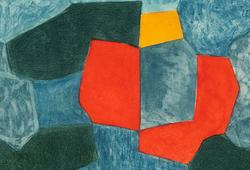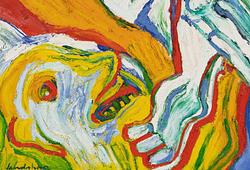Carl Larsson
"Bolla. II"
Signed C.L. within a circle and dated 1913. Oil on canvas 75.5 x 50 cm.
Provenance
Director A. Smith.
Bukowski Auctions, Internationella Höstauktionen 550, 25 - 28 November 2008, lot 168.
Private Collection.
Exhibitions
Liljevalchs konsthall, Stockholm, "Invigningsutställning. Larsson-Liljefors-Zorn", March - Aprl 1916, cat. no 99
Charlottenborg, Köpenhamn, Svenska Konstutställningen, 1916, cat. no 441.
Liljevalchs konsthall, Stockholm, "Minnesutställning. Carl Larsson", 6 March - 5 April 1920, cat. no 290.
Liljevalchs konsthall, Stockholm, "Carl Larsson -100 år- Minnesutställning", 1953, cat. no 338.
Literature
Ernst Malmberg, "Larsson-Liljefors-Zorn - En återblick", 1919, , illustrated full page in a plate work on the hanging at the opening exhibition of the Liljevalchs Art Gallery in 1916.
Ulwa Neergaard, "Carl Larsson. Signerat med pensel och penna", 1999, illustrated full page in colour p. 499 and included in the catalogue supplement under the year 1913, p. 144 as no. 1508.
More information
The girl named Bolla was depicted in two versions, both in a watercolour executed in 1913 and in an oil on canvas (the present painting) the same year. The watercolour (now in the collections of the Jämtlands läns museum in Östersund) portrays Bolla in full figure, while the oil painting focuses on her face and upper body in profile.
Ulwa Neergaard recounts the following in her extensive biography of Carl Larsson:
"Who Bolla was is told by Carl Larsson in a letter from Sundborn to his daughter Lisbeth on 18 January 1913. He writes: 'Here we have had a little youth (well, that is, 28 years old, or so) a Bolla Nilson, sister-in-law to Glasell, who has modelled for us, but has now gone to another sister in Hudiksvall.' Glasell, whom Carl Larsson mentions in his letter, was Theodor Glasell, a beloved and talented drawing teacher in Falun."
Neergaard, again, describes the watercolour as follows: "Carl Larsson has painted Bolla in the Reading Room at Lilla Hyttnäs in Sundborn, as she sits in the most comfortable reading chair with a book in her lap. On the long narrow table beside her lies, under a multitude of books, a canvas, which, as an effective border in the foreground, has a tapestry woven by Carl Larsson's wife, Karin. The closed door behind Bolla leads into the Old Room, the Larsson family's guest room."
Regarding the current catalogue number featuring Bolla in profile, Neergaard provides the following description and information:
"In this portrait of the girl in profile, which Carl Larsson painted in his studio in Sundborn, Bolla is dressed in the same blue blouse with embroidery of orange flowers as in the portrait of her in the reading room. Bolla, with her beautiful chestnut-red hair, her lovely posture, and the beautifully bronzed blouse, was a motif that undoubtedly captivated Carl Larsson's artistic eye."
It is easy to understand and agree with this admiration. The beautiful Bolla was in every respect an excellent subject for a finely nuanced classical portrait executed by the master himself. Through Larsson's efforts, Bolla has been immortalised in a well-balanced composition where the bright colours of Bolla's period-typical blouse are effectively balanced against the characteristic reds and greens of the Larsson family's background.
Artist
Carl Larsson is considered one of the greatest Swedish artists of all time. He was born in Gamla Stan in Stockholm and studied at the Royal Academy of Arts in the years 1866-76. After his studies in Stockholm, he traveled to France and settled in Grèz-sur-Loing. There he mainly painted garden motifs. In France, he met his future wife Karin Bergöö, who was also an artist and came to mean a lot for his artistry. Already during his student years, he made a living as a photo retoucher and cartoonist in the press. It was also during his studies that Larsson got to know Anders Zorn and Bruno Liljefors, together the three are usually called the ABC artists. At the end of the 1880s, Carl and Karin were given "Lilla Hyttnäs" in Sundborn outside Falun by Karin's father, and this is where Larsson's most famous watercolors depicting his family were created. The motifs often depict sunny landscapes with children, crayfish fishing, meals in the green and interior scenes. Larsson is represented, among other, in the National Museum, where "Gustav Vasas intåg i Stockholm" and "Midvinterblot" fills the stairwell. Represented mainly at the National Museum in Stockholm and at the Gothenburg Art Museum.
Read more












































